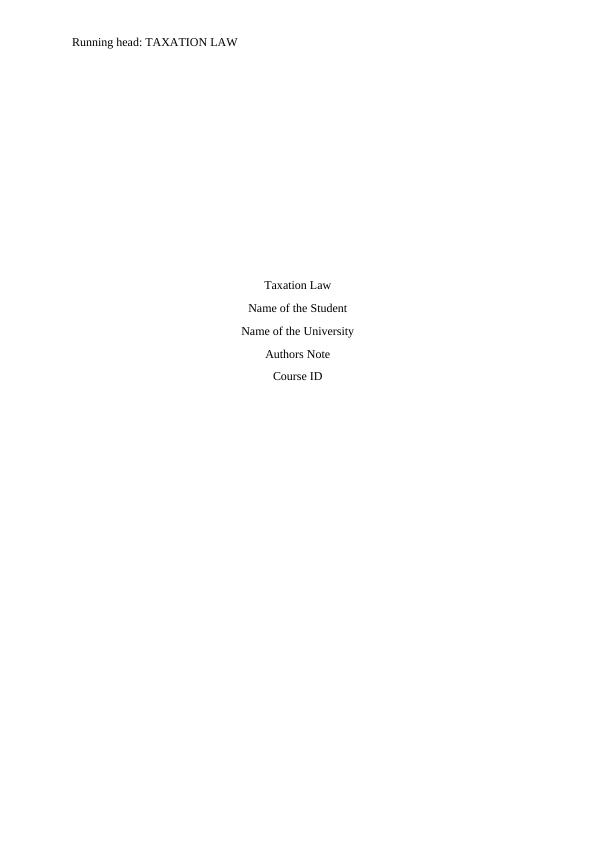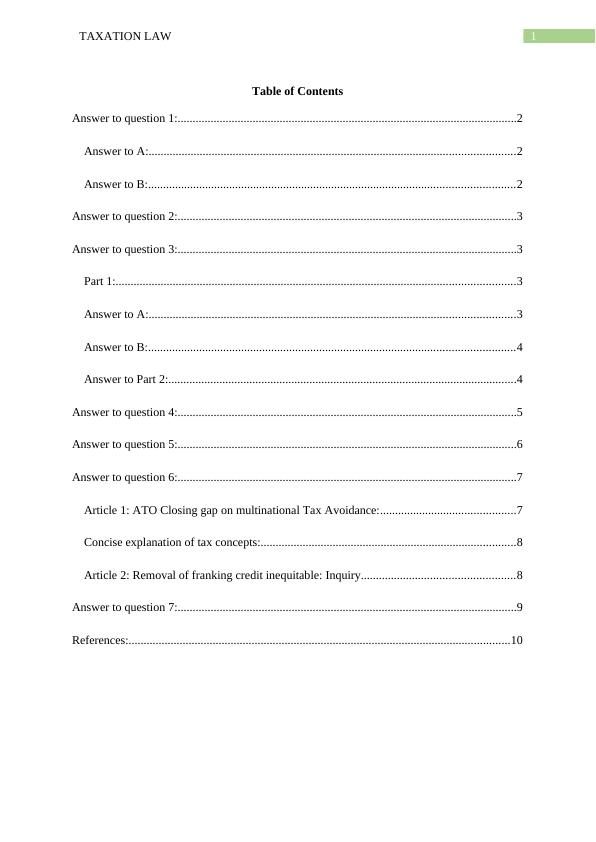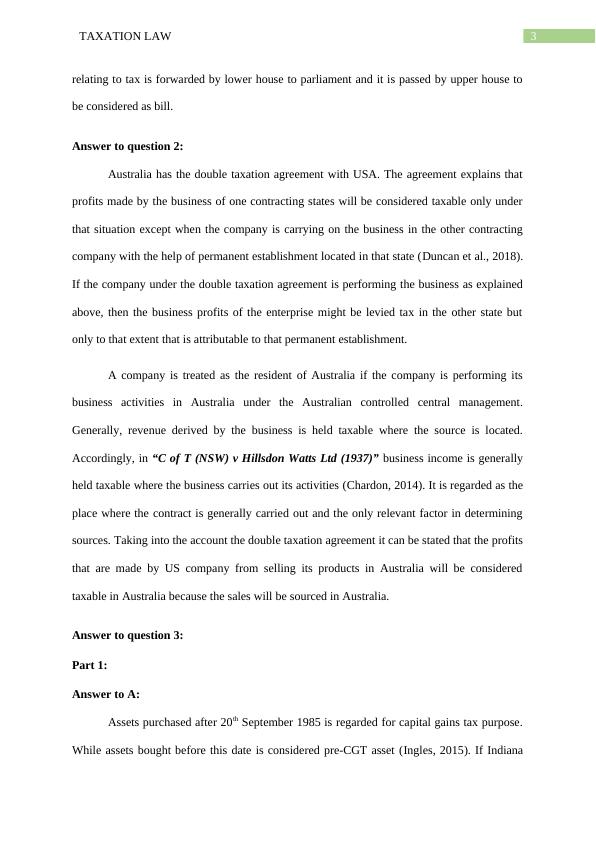Taxation Law
Added on 2023-03-17
12 Pages3033 Words55 Views
Running head: TAXATION LAW
Taxation Law
Name of the Student
Name of the University
Authors Note
Course ID
Taxation Law
Name of the Student
Name of the University
Authors Note
Course ID

1TAXATION LAW
Table of Contents
Answer to question 1:.................................................................................................................2
Answer to A:..........................................................................................................................2
Answer to B:..........................................................................................................................2
Answer to question 2:.................................................................................................................3
Answer to question 3:.................................................................................................................3
Part 1:.....................................................................................................................................3
Answer to A:..........................................................................................................................3
Answer to B:..........................................................................................................................4
Answer to Part 2:....................................................................................................................4
Answer to question 4:.................................................................................................................5
Answer to question 5:.................................................................................................................6
Answer to question 6:.................................................................................................................7
Article 1: ATO Closing gap on multinational Tax Avoidance:.............................................7
Concise explanation of tax concepts:.....................................................................................8
Article 2: Removal of franking credit inequitable: Inquiry...................................................8
Answer to question 7:.................................................................................................................9
References:...............................................................................................................................10
Table of Contents
Answer to question 1:.................................................................................................................2
Answer to A:..........................................................................................................................2
Answer to B:..........................................................................................................................2
Answer to question 2:.................................................................................................................3
Answer to question 3:.................................................................................................................3
Part 1:.....................................................................................................................................3
Answer to A:..........................................................................................................................3
Answer to B:..........................................................................................................................4
Answer to Part 2:....................................................................................................................4
Answer to question 4:.................................................................................................................5
Answer to question 5:.................................................................................................................6
Answer to question 6:.................................................................................................................7
Article 1: ATO Closing gap on multinational Tax Avoidance:.............................................7
Concise explanation of tax concepts:.....................................................................................8
Article 2: Removal of franking credit inequitable: Inquiry...................................................8
Answer to question 7:.................................................................................................................9
References:...............................................................................................................................10

2TAXATION LAW
Answer to question 1:
Answer to A:
The constitutional basis of imposing tax in Australia is mainly found under the
“section 51 (ii)”, “section 90”, “section 53” and “section 96” of the Australian constitution.
The interpretation of the high court of Australia has been integral in the functioning as well
federalist in Australia (McCluskey & Franzsen, 2017). According to the “section 51 (ii)”, of
the Australian constitution, the power to impose tax is given under this section. The areas of
commonwealth power are given under the “section 51”. “Section 51 (ii)” permits the
commonwealth to impose law in relation to the taxation but not to discriminate among the
states and part of the states. The section 90, provides the commonwealth with the power of
imposing tax on the custom duties and excise.
Answer to B:
The development of government tax policy and its application is the responsibility of
the Treasury Ministers. An important role is played by the ATO to formulate the policy and
legislative process that portrays inter-dependence among the laws, policy and governmental
features of taxation system (Evans et al., 2017). The ATO is primarily responsible for the
managing the tax and superannuation laws which the parliament passes. To carry out this, the
administrative arrangements is developed by the ATO which is applied on the tax laws,
education and advising the taxpayers involving their duties and responsibilities.
The high court on the other hand is accountable for interpreting and applying tax in
Australia to make decision on cases that has special significances to the federal along with
the challenges of constitutional validity and hearing the appeals from state, federal and
territory courts (Woellner et al., 2016). The parliament usually is made up of upper and lower
houses. Bills must be passed from upper and lower house to be considered as law. Bills
Answer to question 1:
Answer to A:
The constitutional basis of imposing tax in Australia is mainly found under the
“section 51 (ii)”, “section 90”, “section 53” and “section 96” of the Australian constitution.
The interpretation of the high court of Australia has been integral in the functioning as well
federalist in Australia (McCluskey & Franzsen, 2017). According to the “section 51 (ii)”, of
the Australian constitution, the power to impose tax is given under this section. The areas of
commonwealth power are given under the “section 51”. “Section 51 (ii)” permits the
commonwealth to impose law in relation to the taxation but not to discriminate among the
states and part of the states. The section 90, provides the commonwealth with the power of
imposing tax on the custom duties and excise.
Answer to B:
The development of government tax policy and its application is the responsibility of
the Treasury Ministers. An important role is played by the ATO to formulate the policy and
legislative process that portrays inter-dependence among the laws, policy and governmental
features of taxation system (Evans et al., 2017). The ATO is primarily responsible for the
managing the tax and superannuation laws which the parliament passes. To carry out this, the
administrative arrangements is developed by the ATO which is applied on the tax laws,
education and advising the taxpayers involving their duties and responsibilities.
The high court on the other hand is accountable for interpreting and applying tax in
Australia to make decision on cases that has special significances to the federal along with
the challenges of constitutional validity and hearing the appeals from state, federal and
territory courts (Woellner et al., 2016). The parliament usually is made up of upper and lower
houses. Bills must be passed from upper and lower house to be considered as law. Bills

3TAXATION LAW
relating to tax is forwarded by lower house to parliament and it is passed by upper house to
be considered as bill.
Answer to question 2:
Australia has the double taxation agreement with USA. The agreement explains that
profits made by the business of one contracting states will be considered taxable only under
that situation except when the company is carrying on the business in the other contracting
company with the help of permanent establishment located in that state (Duncan et al., 2018).
If the company under the double taxation agreement is performing the business as explained
above, then the business profits of the enterprise might be levied tax in the other state but
only to that extent that is attributable to that permanent establishment.
A company is treated as the resident of Australia if the company is performing its
business activities in Australia under the Australian controlled central management.
Generally, revenue derived by the business is held taxable where the source is located.
Accordingly, in “C of T (NSW) v Hillsdon Watts Ltd (1937)” business income is generally
held taxable where the business carries out its activities (Chardon, 2014). It is regarded as the
place where the contract is generally carried out and the only relevant factor in determining
sources. Taking into the account the double taxation agreement it can be stated that the profits
that are made by US company from selling its products in Australia will be considered
taxable in Australia because the sales will be sourced in Australia.
Answer to question 3:
Part 1:
Answer to A:
Assets purchased after 20th September 1985 is regarded for capital gains tax purpose.
While assets bought before this date is considered pre-CGT asset (Ingles, 2015). If Indiana
relating to tax is forwarded by lower house to parliament and it is passed by upper house to
be considered as bill.
Answer to question 2:
Australia has the double taxation agreement with USA. The agreement explains that
profits made by the business of one contracting states will be considered taxable only under
that situation except when the company is carrying on the business in the other contracting
company with the help of permanent establishment located in that state (Duncan et al., 2018).
If the company under the double taxation agreement is performing the business as explained
above, then the business profits of the enterprise might be levied tax in the other state but
only to that extent that is attributable to that permanent establishment.
A company is treated as the resident of Australia if the company is performing its
business activities in Australia under the Australian controlled central management.
Generally, revenue derived by the business is held taxable where the source is located.
Accordingly, in “C of T (NSW) v Hillsdon Watts Ltd (1937)” business income is generally
held taxable where the business carries out its activities (Chardon, 2014). It is regarded as the
place where the contract is generally carried out and the only relevant factor in determining
sources. Taking into the account the double taxation agreement it can be stated that the profits
that are made by US company from selling its products in Australia will be considered
taxable in Australia because the sales will be sourced in Australia.
Answer to question 3:
Part 1:
Answer to A:
Assets purchased after 20th September 1985 is regarded for capital gains tax purpose.
While assets bought before this date is considered pre-CGT asset (Ingles, 2015). If Indiana

End of preview
Want to access all the pages? Upload your documents or become a member.
Related Documents
Taxation Lawlg...
|12
|2912
|77
Taxation Lawlg...
|12
|2985
|62
Taxation Lawlg...
|12
|2825
|55
Taxation Lawlg...
|12
|2952
|67
Australian Taxation Law – PDFlg...
|12
|2610
|220
Australian Taxation Law- Assignmentlg...
|11
|3079
|459
